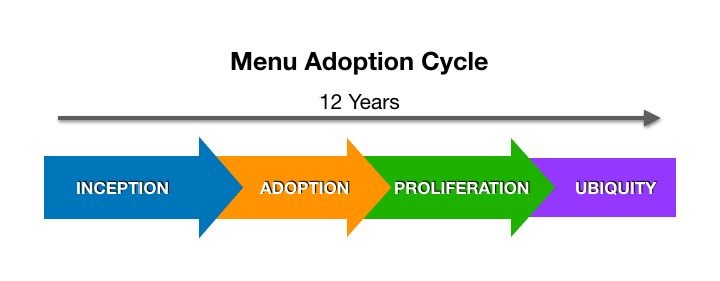
Vol. XIX, No. 7, August 2019
- Editor's corner
- Attention spans are shortening; trends don't last as long
- The evolution of the FEC industry - over expansion and opportunity
- Big investment in immersive mixed-use entertainment by Kevin Williams
- The cannibals are eating the CLV industry
- Essentials of hayride safety
- Is the obsession with beer justified?
- Review of Bar K - a multispecies social eatertainment venue by Linda Beckring
- The importance of great restaurant ambiance
- Do you know your cost of goods sold percentage?
- Jim Kessler gives it to us straight
- Cathedral-tainment
- Home is the new hangout
- Out-of-home entertainment & arts spending by occupation
- Randy's travel tips
Attention spans are shortening; trends don't last as long
Yes, as you may have suspected, our attention spans are getting shorter due to a phenomenon known in academia as 'social acceleration,' living in times of accelerating change. As a society, our attention span is narrowing due to the ever-growing amount of information we have available to us. A recent research study found that as a result of the more things we have to focus on, collectively we often focus on things for a shorter period of time.
While social media and the 'fear of missing out' (FoMO) definitely play a role in this shift to shorter attention spans, it is not all to blame. The researchers found that the trend started at least a hundred years ago.
As the number of options increases, the more sharply they capture widespread attention and promptly lose it just as quickly. The researchers examined trends with Google Trends over eight years, movie popularity over the past 40 years and even book readership over the past 100 years. One recent example they examined was that in 2013, a Twitter global trend would last for an average of 17.5 hours, contrasted with a 2016 Twitter trend, which lasted for only 11.9 hours.
Professor Sune Lehmann from the Technical University of Denmark who worked on the study said: “It seems that the allocated attention time in our collective minds has a certain size, but the cultural items competing for that attention have become more densely packed [more of them].”
Philipp Lorenz-Spreen of Max Planck Institute for Human Development that also participated in the study put it this way, “Content is increasing in volume, which exhausts our attention and our urge for 'newness' causes us to collectively switch between topics more regularly.”
The researchers found that the heights of the peaks of attention [maximum popularity] have remained roughly the same, but topics become popular more rapidly and interest fades away at a similarly increased rate. What this means is trends increasingly don't last as long.
Implications for community leisure venues
We're seeing this phenomenon play out with community leisure venues (CLVs) of all types, whether it is with the food and beverage or with entertainment and attractions. New items, whether some new food, drink or attraction, are having far shorter popularity than in the past. With food and drink, the menu adoption cycle from inception to ubiquity used to take 12 years. Today with the ever-expanding food and beverage options consumers have, that cycle time has been roughly cut in half to six years

A new type attraction that might have been good for five years not that long ago might today only have around a two-year life before its popularity fades. Things like ropes courses and axe throwing are just a few examples that fall into shorter life spans than they might have had a decade ago when there were far fewer out-of-home entertainment options and type activities.
And that is a major issue with shorter life cycles for new attractions today. The major markets are being flooded with out-of-home leisure and entertainment options, including not only an explosion of new venues of all types, but also a large number of one-time and limited time events, including festivals and fairs. Their short limited-time duration increases their appeal over fixed attractions due to FoMO and their uniqueness. So, as the options expand, we can expect the appeal popularity of attractions and events to fade even more quickly.
We've previously written about this from the standpoint of a loss of repeat appeal for entertainment venues - been there, done that, let's move on to all the other options as there's more to do than we have time to and so many new ones to check out. And of course, the desire to post multiple unique experiences on social media to gain social capital and add to experiential CVs is further feeding the loss of repeat appeal and shorter life cycles.
What this means for OOH entertainment venues is two-fold:
- New venue types and attractions will have far shorter lives than in the past and far less repeat appeal
- In addition to fixed attractions, a CLV's mix now needs to include multiple and constantly changing one- and limited-time events to drive attendance, especially repeat attendance.
Research source: Lorenz-Spreen, Philipp, et al. "Accelerating dynamics of collective attention." Nature communications 10.1 (2019): 1759.
Vol. XIX, No. 7, August 2019
- Editor's corner
- Attention spans are shortening; trends don't last as long
- The evolution of the FEC industry - over expansion and opportunity
- Big investment in immersive mixed-use entertainment by Kevin Williams
- The cannibals are eating the CLV industry
- Essentials of hayride safety
- Is the obsession with beer justified?
- Review of Bar K - a multispecies social eatertainment venue by Linda Beckring
- The importance of great restaurant ambiance
- Do you know your cost of goods sold percentage?
- Jim Kessler gives it to us straight
- Cathedral-tainment
- Home is the new hangout
- Out-of-home entertainment & arts spending by occupation
- Randy's travel tips


